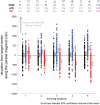Prediction error induced motor contagions in human behaviors
- PMID: 29807568
- PMCID: PMC5973832
- DOI: 10.7554/eLife.33392
Prediction error induced motor contagions in human behaviors
Abstract
Motor contagions refer to implicit effects on one's actions induced by observed actions. Motor contagions are believed to be induced simply by action observation and cause an observer's action to become similar to the action observed. In contrast, here we report a new motor contagion that is induced only when the observation is accompanied by prediction errors - differences between actions one observes and those he/she predicts or expects. In two experiments, one on whole-body baseball pitching and another on simple arm reaching, we show that the observation of the same action induces distinct motor contagions, depending on whether prediction errors are present or not. In the absence of prediction errors, as in previous reports, participants' actions changed to become similar to the observed action, while in the presence of prediction errors, their actions changed to diverge away from it, suggesting distinct effects of action observation and action prediction on human actions.
Keywords: action execution; action observation; human; motor contagion; neuroscience; prediction error.
© 2018, Ikegami et al.
Conflict of interest statement
TI, GG, TT, HN No competing interests declared
Figures








Similar articles
-
Visual background information modulates motor contagions in humans.Sci Rep. 2024 Aug 13;14(1):18789. doi: 10.1038/s41598-024-69535-9. Sci Rep. 2024. PMID: 39138248 Free PMC article.
-
[Implicit Effects of Other's Actions on One's Own Actions in Sports].Brain Nerve. 2019 Feb;71(2):113-124. doi: 10.11477/mf.1416201230. Brain Nerve. 2019. PMID: 30718440 Review. Japanese.
-
Motor contagion: goal-directed actions are more contagious than non-goal-directed actions.Exp Psychol. 2011;58(1):71-8. doi: 10.1027/1618-3169/a000069. Exp Psychol. 2011. PMID: 20494864
-
Nonlinear engagement of action observation network underlying action anticipation in players with different levels of expertise.Hum Brain Mapp. 2020 Dec 15;41(18):5199-5214. doi: 10.1002/hbm.25186. Epub 2020 Aug 26. Hum Brain Mapp. 2020. PMID: 32845066 Free PMC article.
-
Activating the motor system through action observation: is this an efficient approach in adults and children?Dev Med Child Neurol. 2015 Apr;57 Suppl 2:42-5. doi: 10.1111/dmcn.12686. Dev Med Child Neurol. 2015. PMID: 25690116 Review.
Cited by
-
Recognition capability of one's own skilled movement is dissociated from acquisition of motor skill memory.Sci Rep. 2021 Aug 18;11(1):16710. doi: 10.1038/s41598-021-96381-w. Sci Rep. 2021. PMID: 34408254 Free PMC article. Clinical Trial.
-
Visual background information modulates motor contagions in humans.Sci Rep. 2024 Aug 13;14(1):18789. doi: 10.1038/s41598-024-69535-9. Sci Rep. 2024. PMID: 39138248 Free PMC article.
-
Short-term evidence of partner-induced performance biases in simultaneous and alternating dyad practice in golf.Sci Rep. 2023 Nov 30;13(1):21099. doi: 10.1038/s41598-023-48133-1. Sci Rep. 2023. PMID: 38036574 Free PMC article.
-
Neural signals implicated in the processing of appetitive and aversive events in social and non-social contexts.Front Syst Neurosci. 2022 Aug 3;16:926388. doi: 10.3389/fnsys.2022.926388. eCollection 2022. Front Syst Neurosci. 2022. PMID: 35993086 Free PMC article. Review.
-
The where of handovers by humans: Effect of partner characteristics, distance and visual feedback.PLoS One. 2019 Jun 21;14(6):e0217129. doi: 10.1371/journal.pone.0217129. eCollection 2019. PLoS One. 2019. PMID: 31226108 Free PMC article.
References
-
- Adams JA. Use of the model’s knowledge of results to increase the observer’s performance. Journal of Human Movement Studies. 1986;12:89–98.
Publication types
MeSH terms
LinkOut - more resources
Full Text Sources
Other Literature Sources

